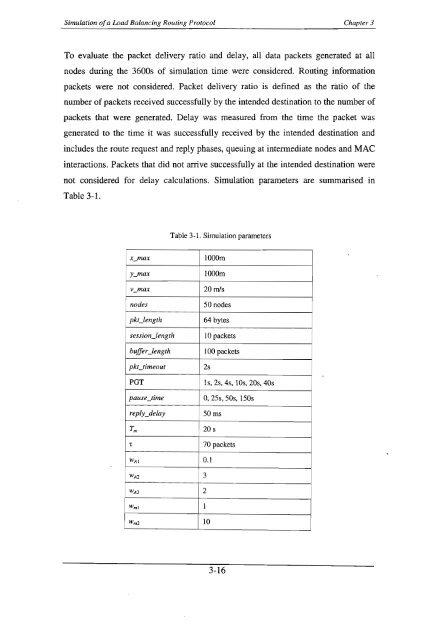Gugrajah_Yuvaan_ Ramesh_2003.pdf
Gugrajah_Yuvaan_ Ramesh_2003.pdf
Gugrajah_Yuvaan_ Ramesh_2003.pdf
You also want an ePaper? Increase the reach of your titles
YUMPU automatically turns print PDFs into web optimized ePapers that Google loves.
Simulationofa Load Balancing Routing Protocol<br />
Chapter 3<br />
To evaluate the packet delivery ratio and delay, all data packets generated at all<br />
nodes during the 3600s of simulation time were considered. Routing information<br />
packets were not considered. Packet delivery ratio is defined as the ratio of the<br />
number of packets received successfully by the intended destination to the number of<br />
packets that were generated. Delay was measured from the time the packet was<br />
generated to the time it was successfully received by the intended destination and<br />
includes the route request and reply phases, queuing at intermediate nodes and MAC<br />
interactions. Packets that did not arrive successfully at the intended destination were<br />
not considered for delay calculations. Simulation parameters are summarised in<br />
Table 3-1.<br />
Table 3-1. Simulation parameters<br />
x_max 1000m<br />
y_max 1000m<br />
v_max 20m/s<br />
nodes 50 nodes<br />
pkUength 64 bytes<br />
session_length 10 packets<br />
buffer_length 100 packets<br />
pkCtimeout 2s<br />
PGT 1s, 2s, 4s, lOs, 20s, 40s<br />
pause_time 0, 25s, 50s, 150s<br />
reply_delay 50ms<br />
T m<br />
20 s<br />
t 70 packets<br />
WAI<br />
WA2<br />
WA3<br />
Wml<br />
0.1<br />
W m2 10<br />
3<br />
2<br />
1<br />
3-16
















